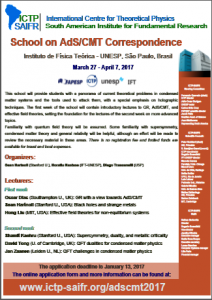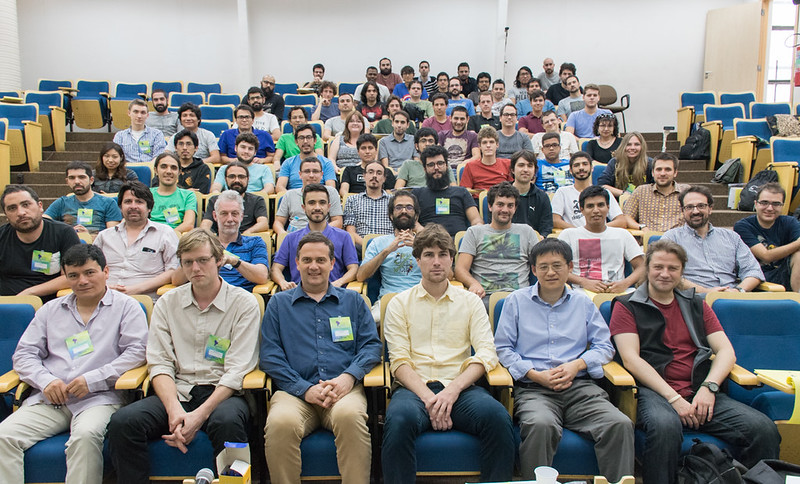School on AdS/CMT Correspondence
March 27 – April 7, 2017
São Paulo, Brazil
ICTP-SAIFR/IFT-UNESP
![]()
Home
This school will provide students with a panorama of current theoretical problems in condensed matter systems and the tools used to attack them, with a special emphasis on holographic techniques. The first week of the school will contain introductory lectures to GR, AdS/CMT, and effective field theories, setting the foundation for the lectures of the second week on more advanced topics.
Familiarity with quantum field theory will be assumed. Some familiarity with supersymmetry, condensed matter theory and general relativity will be helpful, although an effort will be made to review the necessary material in these areas. There is no registration fee and limited funds are available for travel and local expenses.
Organizers:
- Sean Hartnoll (Stanford University, USA)
- Horatiu Nastase (IFT-UNESP, Brazil)
- Diego Trancanelli (USP, Brazil)
Satisfaction survey:
- click here
Lecturers
First week
Oscar Dias (Southampton University, UK): GR with a view towards AdS/CMT
In these lectures we will start with a nutshell introduction to General Relativity (GR) and in particular to GR in AdS spacetimes. This will be followed by another nutshell introduction, this time to the AdS/CFT correspondence which is the foundational building of the AdS/CMT correspondence that will be deeply studied during this school. Finally, we will introduce numerical methods to construct gravitational solutions, which are in particular tailored for AdS backgrounds of interest for the AdS/CMT correspondence.
Bibliography:
1) GR: http://200.145.112.247/QCD/reviewGR.pdf
[ for a full course on GR see e.g.: https://arxiv.org/abs/gr-qc/9712019 ]
2) AdS/CFT: https://arxiv.org/abs/1106.6073 + Chapter 1 of https://arxiv.org/abs/1612.07324 + Chapter 4 & 5 of https://arxiv.org/abs/1101.0618 + Chapters 8 & 9 of https://arxiv.org/pdf/0712.0689.pdf
3) Numerical methods: https://arxiv.org/abs/1510.02804 (in particular Chapters 3,4,6 & 7) + https://arxiv.org/abs/1107.5513
Sean Hartnoll (Stanford University, USA): Black holes and strange metals
Bibliography: Holographic quantum matter
Hong Liu (Massachusetts Institute of Technology – MIT, USA): Effective field theories for non-equilibrium systems
We will discuss formulation of hydrodynamics as a universal low energy effective field theory for a quantum many-body system. We will also provide a new proof of the second law of thermodynamics for systems in local equilibrium and show that such systems have an emergent supersymmetry.
References: arXiv:1511.03646, arXiv:1612.07705, arXiv:1701.07817, arXiv:1701.07445
Second week
Shamit Kachru (Stanford University, USA): Dualities and metallic criticality
I’ll talk about a variety of field theory dualities, old and new, that are of potential use in condensed matter physics. Then I will discuss one outstanding challenge for field theory techniques in condensed matter, that of understanding metallic criticality.
Bibliography: arXiv:1608.05077, arXiv:1609.02149, arXiv:1307.0004, arXiv:1312.3321 + textbook sources for review of older material, such as Fradkin’s “Field theories of condensed matter physics”.
David Tong (University of Cambridge, UK): Progress in d=2+1 Field Theories
Bibliography: Lectures on the Quantum Hall Effect, especially Section 5.
Jan Zaanen (Leiden U., The Netherlands): Quantum field theory challenges in condensed matter physics
These lectures will follow roughly the discussion in chapters 2, 3 and 14 in the book “Holographic duality in Condensed Matter Physics” by myself, Sun, Liu and Schalm (Cambridge Univ. Press, 2015). Additional background reading material will be indicated.
Lecture 1: General perspective: matter and quantum information. Short ranged entangled product states, spontaneous symmetry breaking and rigidity: review of the condensed matter textbooks. The strange rigidity of the Fermi liquid. (e.g. Nayak’s lecture notes: http://www.physics.ucla.edu/~nayak/many_body.pdf)
Lecture 2: Quantum field theory and bosons at a finite density. Weak-strong duality and the emergence of gauge fields. The strongly interacting quantum critical state: infinite party entanglement, the ETH and Planckian dissipation. Fermions and Herz-Millis. S. Sachdev, “Quantum Phase transitions” (CUP, 2011); Duality, arXiv:1108.2791, arXiv:1603.04254 (Zaanen);
Lecture 3: Macroscopic entanglement and topological order. Stripe- and Cooper-pair fractionalization versus the emergent gauge fields of string nets. The BCS superconductor as a Z2 spin liquid. Tensor networks. Fermionic entanglement in compressible systems: the nodal surface and the Mott collapse. String nets arXiv:1210.1281 (Wen); Tensor networks arXiv 1306.2164 (Orus); fermions arXiv:0802.2455, arXiv:1605.02477 (Zaanen). Mottness arXiv:0911.4070 (Zaanen).
Lecture 4: Condensed matter experiments and the intellectual crisis: the need for a new paradigm. A short history of high Tc superconductivity and other correlated electron systems. Mottness, stripyness and other complex behaviours versus the big numerical machines. The strange metals. History arXiv:1012.5461 (Zaanen); Cuprates, Nature 518, 179, 2015 (Keimer); Heavy fermions RMP 79, 1015, 2007 (Lohneisen); intertwined order arXiv:1407.4480 (Fradkin), arXiv:1701.00054 (Zheng)
Lecture 5: The lessons of holography as the mean field theory of maximal entanglement. Strange metals as emergent critical phases. Incoherent spectra and unparticle physics. Collective transport versus single particles: Planckian dissipation. The “dark matter” of holographic superconductors. What sets Tc’s?
Poster
Program
School Program: PDF version (updated on March 15, 2017)
Photos
Files & Exercises
Oscar Dias (Southampton University, UK): GR with a view towards AdS/CMT
Jan Zaanen (Leiden U., The Netherlands): Quantum field theory challenges in condensed matter physics
- String theorists need Eddington!
- The intertwined order of underdoped cuprates
- Mottness and the Emergent Fermi liquid
Short talks:
- Ignacio Reyes, “The phases of higher spin black holes”
- Carlos Bessa, “Analog Quantum Gravity Effects in Dielectrics”
- Raul Arias, “Spontaneous current in an holographic s+p superfluid”
- Bruno Loureiro, “Disorder in AdS/CMT”
- Ignacio Salazar Landea, “The g-theorem and quantum information theory”
- Alfredo Herrera Aguilar, “Ricci flows and possible applications to phase transitions in CMT”
- Jarkko Jarvela, “Non-relativistic anyonic holographic matter”
- Nicolas Kovensky, “On antisymmetric contributions to holographic DIS and the five-dimensional Chern-Simons term”
Additional Information
List of Confirmed Participants: Updated on March 22
Poster presentation: Participants who are presenting a poster MUST BRING THE POSTER PRINTED. The poster size should be at most 1,5m x 1m.
Registration: ALL participants should register. The registration will be on March 27 at the institute from 8:00 to 9:00 am. You can find arrival instructions at http://www.ictp-saifr.org/?page_id=195
Accommodation: Participants, whose accommodation has been provided by the institute will stay at The Universe Flat. Each participant, whose accommodation has been provided by the institute, has received the accommodation details individually by email.
BOARDING PASS: All participants, whose travel has been provided or will be reimbursed by the institute, should bring the boarding pass upon registration, and collect an envelope to send the return boarding pass to the institute.
Emergency number: 9 8233 8671 (from São Paulo city); +55 11 9 8233 8671 (from abroad), 11 9 8233 8671 (from outside São Paulo).
Ground transportation instructions:
Ground transportation from Guarulhos Airport to The Universe Flat
Ground transportation from Congonhas Airport to the Universe Flat
Ground transportation from The Universe Flat to the institute

